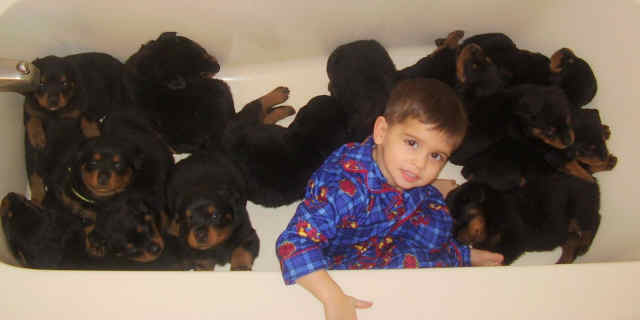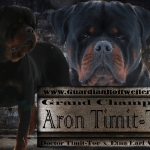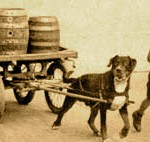Unfortunately, intestinal parasites are part of the territory with both puppies and dogs. They lick their bums, each other bums, drink from puddles, ponds, creeks and toilets, pick up sticks and poo and love to play in the mud. Thinking you will prevent your dog from ever getting an intestinal parasite is extremely unlikely. Aside from choosing a quality dog food, the next biggest thing you can do for yo ur furry friend is keep them on a good flea/tick preventative and monthly heart worm preventative. Most heartworm preventatives are also intestinal parasite dewormers. This is fantastic because not only are you saving your dog from the deadly heartworm, but you are also giving it a once a month dewormer to prophylactically eliminate any free loading tummy bugs. Because of how much we travel, we quarterly deworm our dogs REGARDLESS of symptoms. Our dogs swim in the pond, romp in the woods, travel and play with other dogs that travel. Just like trying to keep kids spotless and live in the country is not only futile but no fun, so is attempting to prevent your dog/pup from ever picking up or licking something it should not. Even if your dog or puppy never got near woods, rivers, etc. you could have a bug or small animal walk through contaminated water or feces then walk over your dogs food or toys or an infested bird drop poop flying over head in their water bowl.
ur furry friend is keep them on a good flea/tick preventative and monthly heart worm preventative. Most heartworm preventatives are also intestinal parasite dewormers. This is fantastic because not only are you saving your dog from the deadly heartworm, but you are also giving it a once a month dewormer to prophylactically eliminate any free loading tummy bugs. Because of how much we travel, we quarterly deworm our dogs REGARDLESS of symptoms. Our dogs swim in the pond, romp in the woods, travel and play with other dogs that travel. Just like trying to keep kids spotless and live in the country is not only futile but no fun, so is attempting to prevent your dog/pup from ever picking up or licking something it should not. Even if your dog or puppy never got near woods, rivers, etc. you could have a bug or small animal walk through contaminated water or feces then walk over your dogs food or toys or an infested bird drop poop flying over head in their water bowl.
Wow! With all that, what exactly can one do?? Easy, the same thing I do when my kids get dirty- put them in the bathtub! Not that you need to put the dogs in the bathtub every day to prevent or treat intestinal parasites, it was just a metaphor meaning, no worries, just take care of it. Intestinal parasites are pretty easy to treat and some- roundworm and hookworm are automatically treated every month with your heartworm preventative if you are using Heartguard Plus or Interceptor- and Interceptor will also treat whipworm.
When a dog or puppy presents with diarrhea, my 2 first thought are always- potential intestinal parasite or something in the diet does not agree with the puppy/dog. We do random stool samples through out the year for fecal exams as well as when a dog/pup has runny stool for more than a few days. Here are some of the most common intestinal parasites as well as some methods of treatment.
ROUNDWORM
 Almost all puppies get roundworm from their mother- either while developing or via her milk. Dogs also pickup roundworm from infected soil. It has been calculated that as much as 10% of all planting soil contains roundworm eggs! There are 2 main types of roundworm: Toxocara canis and Toxascaris leonina. Because both are treated with the same meds, it is usually not necessary to differentiate between the 2, however, since Toxocara leonnina can be transmitted to cats or from cats, sometimes differentiation can sometimes be helpful in identifying any other pets that may need treatment.
Almost all puppies get roundworm from their mother- either while developing or via her milk. Dogs also pickup roundworm from infected soil. It has been calculated that as much as 10% of all planting soil contains roundworm eggs! There are 2 main types of roundworm: Toxocara canis and Toxascaris leonina. Because both are treated with the same meds, it is usually not necessary to differentiate between the 2, however, since Toxocara leonnina can be transmitted to cats or from cats, sometimes differentiation can sometimes be helpful in identifying any other pets that may need treatment.
There are 4 main methods of infection to a dog or puppy. As mentioned above, the parasite can be transferred to the developing embryo by mom or passed to the puppy in the milk. The eggs can also be consumed through normal grooming if the dog/puppy has come in contact with infested soil, or it can be ingested from the tissue of another infected animal.
Once you understand the lifecycle of the roundworm, it is easier to understand both infestation and treatment.
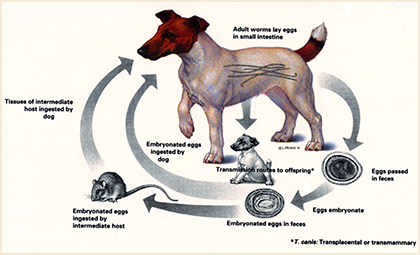 STAGE 1:
STAGE 1:
In the first stage of infestation, the eggs are shed from an infected host. The worm inside will need about a month to develop before it is capable of causing its own infestation, however, roundworm eggs are known for their hardiness and can survive for months or even years in favorable conditions and remain capable of infecting.
STAGE 2:
The egg, containing the “second stage larva” is picked up by the dog or another animal usually through grooming (meaning the dog sat or stepped in contaminated dirt and then licked himself; can also be picked up if a toy or food is on the ground and then picked up). Once the egg hatches in the new host’s intestinal track, it burrows out of the intestines to encyst in the hosts other tissues. (If the host is another animal other than a dog, the cysts will simply wait until the animal is consumed by a dog.) If the stage 2 host is a dog, the roundworm life cycle continues.
STAGE 3:
The stage 2 larva can remain encysted for years until conditions are ideal to continue. If the host is a dog, the liver is the most common place for roundworm larva to encyst. When they are ready to move on, they will migrate to the lungs and develop into “third stage larvae”. A heavy enough infestation can cause pneumonia. Once they have migrated to the upper airways in the throat coughing is induced. The dog then swallows the worms it has coughed up thus placing them back in the intestinal track of the dog. In a pregnant dog, the larva do not migrate to the liver but rather to the uterus to infest the developing puppies or to the mammary glands to be ingested by the puppies. Here it will enter their lungs to develop into stage 3 larva, and then be coughed and swallowed into the intestinal track of the puppies.
STAGE 4:
Once back in the intestine, the mature worms being to mate and the first batch of eggs are laid about a week after the worms have arrived back in the intestine and about 4-5 weeks after the host first encountered them.
Unfortunately, deworming only eliminates the worms and the the encysted larvae which is why it is almost impossible to prevent the roundworm from being passed to newborn puppies. As a general rule, all newborn puppies are assumed to have roundworm and are dewormed accordingly.
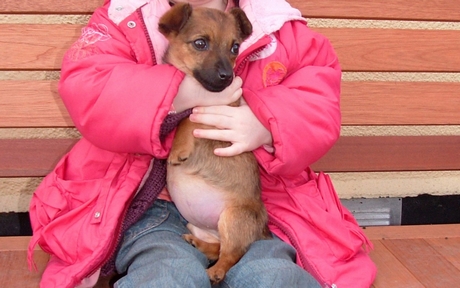 What happens if the dogs or puppies are never dewormed?
What happens if the dogs or puppies are never dewormed?
As stated previously, intestinal parasites area common cause of diarrhea in puppies and young dogs. A heavy infection can also cause vomiting. Besides being uncomfortable and making potty training difficult, the side effects in young puppies can be deadly. When a puppy only weighs a few pounds or less, it obviously cannot afford to loose very much before becoming compromised. Because the worms attach to the dog/puppy’s intestinal track to feed, a heavy infestation will also rob the developing puppy of vital nutrients and can lead to the “pot-bellied” appearance often seen in infected puppies. The roundworm can also cause pneumonia as it migrates to the lungs if the infestation is heavy enough or even obstruct the intestinal tract altogether.
TREATMENT.
Interceptor and Heartguard will act as a monthly dewormer once your puppy is old enough to receive these once a month although additional deworming may occasionally be necessary. The best dewormers for canine roundworms are Pyrantel Pamoate, Drontal (Febantel Panacur (Fembendazole). It is important to note that when a puppy has been dewormed, the medicine anesthetizes the roundworm so that it releases its grip in the intestinal track and can be passed out. The worms may still be alive when they are passed with the stool, but cannot survive outside of the dog’s intestinal track and will soon die. I can tell you from experience, the first time you see roundworms in your puppy or dog’s stool, you will likely not be in the mood for spaghetti for quite some time! Follow up deworming is essential! As previously stated, the dewormers only get rid of the worms and have no effect on the encysted larva, so you must deworm again once they have made their way to the intestines. Usually a second and sometimes a third round of deworming is necessary. A follow up fecal exam should be done to ensure there were not missed parasites.
HOOKWORM
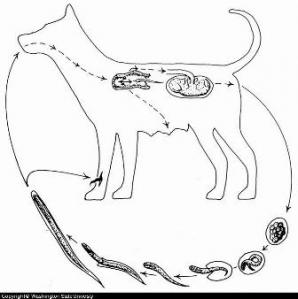 Hookworms are thus named because of the hooks that attach them to the intestinal track of their hosts. Just like with roundworms, hookworms can be passed to puppies from pregnant and lactating moms via their milk. Hookworms can also be ingested through contaminated soil or the tissue of other animals. However, unlike roundworms, hookworms can also actively borrow into the dog’s skin- usually through the pad of the foot.
Hookworms are thus named because of the hooks that attach them to the intestinal track of their hosts. Just like with roundworms, hookworms can be passed to puppies from pregnant and lactating moms via their milk. Hookworms can also be ingested through contaminated soil or the tissue of other animals. However, unlike roundworms, hookworms can also actively borrow into the dog’s skin- usually through the pad of the foot.
Once again, if you understand the life cycle, you can better understand and treat the parasite. Adult hookworms live in the small intestines of dogs. From here, they lay eggs which are passed with the dog’s feces into the environment. Within 48 hours in ideal conditions, the egg will hatch and the host will be ready to infest in 5-7 days. Once picked up by the host, the larvae migrate until they reach the intestines where they become adult egg-laying hookworms and complete the cycle. The larvae that do not reach the gut encyst in other tissue and can remain dormant until a stimulus such as pregnancy activates them and restarts their migration to the gut.
What does hookworm do?
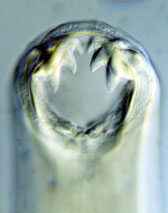 The hookworms that are not digested and enter the dog externally can cause damage as they migrate towards the intestine. In the skin, they can cause irritation and itching. As they borrow through the lungs, they can cause coughing and inflammation. The parasites that make it to the intestine attach to the mucosa of the intestinal wall with hook-like teeth and drain blood and tissue fluid from the dog or puppy. They can cause malnutrition, anemia, lethargy and bloody diarrhea. This can be especially deadly to puppies. Studies indicate that the presence of 500 worms will cause a 5 pound puppy to lose half of its blood volume in one day leading to death!
The hookworms that are not digested and enter the dog externally can cause damage as they migrate towards the intestine. In the skin, they can cause irritation and itching. As they borrow through the lungs, they can cause coughing and inflammation. The parasites that make it to the intestine attach to the mucosa of the intestinal wall with hook-like teeth and drain blood and tissue fluid from the dog or puppy. They can cause malnutrition, anemia, lethargy and bloody diarrhea. This can be especially deadly to puppies. Studies indicate that the presence of 500 worms will cause a 5 pound puppy to lose half of its blood volume in one day leading to death!
Treatment.
Like roundworm, hookworm is also taken care of with your monthly Interceptor or Heartguard. But if you are not using these or have an outbreak, there are several very effective products: Nemex, Panacur, Drontal Plus, Telmintic, and Vercom Paste. And just like with roundworm, deworming should be repeated in one to two weeks, because the initial deworming activates encysted larvae and causes a new crop of adult worms to appear in 10 to 12 days. A follow-up fecal examination is recommended to be sure all parasites have been removed.
WHIPWORM
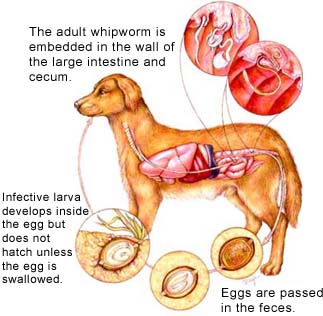 The adult whipworm is 2-3 inches in length, very thin (like a thread) except for one end that is thickened- giving it the appearance of a whip. Adult whipworms live at the end of the small intestines and beginning of the large intestines. They attach to the to the gut lining and feed. Adult female whipsworms lay much less eggs than my other intestinal parasites and can also go through long periods without laying eggs. This makes finding eggs in a fecal exam more difficult.
The adult whipworm is 2-3 inches in length, very thin (like a thread) except for one end that is thickened- giving it the appearance of a whip. Adult whipworms live at the end of the small intestines and beginning of the large intestines. They attach to the to the gut lining and feed. Adult female whipsworms lay much less eggs than my other intestinal parasites and can also go through long periods without laying eggs. This makes finding eggs in a fecal exam more difficult.
Once attached to the intestinal wall, the female whipworm lays eggs that are shed into the environment through the dog’s stool. Once in the environment, the larva develops inside the egg for about a month but will not hatch until it is is ingested by th e dog.
e dog.
The symptoms of whipworm will vary with the amount of whipworms present. A low volume may not show any symptoms at all where as a larger number of parasites can cause inflammation of the intestinal wall and produce diarrhea, weight loss and anemia. The diarrhea is often bloody and with excess mucous. The diarrhea can be acute (sudden and strong), chronic (prolonged and repeated episodes), or intermittent (it comes and goes). This can often lead to colitis, or difficulty going, straining and a cause a sense of urgency to go.
TREATMENT.
If you are using Interceptor as your monthly heartworm preventative, it will also treat whipworms. There are also several dewormers available that are very effective: Panacur, Drontal Plus, Telmintic, and Vercom Paste. However, because it is difficult to get a higher concentration of the dewormer in the colon where the whipworms reside, they can be more difficult to eliminate. The most effective deworming schedule to coincide with the life cycle of the whipworm is to repeat the worming at 3 weeks and then again at 3 months. The whipworm egg is very hardy and can live in the environment for up to 5 years! In areas such as public parks, dog parks, etc. re-infestation is common. Keeping stool picked up on a daily basis is the easiest way to help control and eliminate many parasite problems.
TAPEWORM
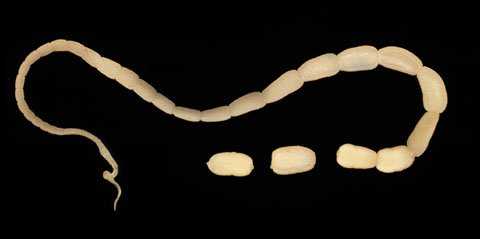 This is a parasite that I am happy to say I have never had the displeasure of meeting. It can be anywhere from less than an inch to a few feet in length! The entire concept of this parasite just creeps me out! It attaches to the gut of your dog via hooks and suckers on the head and then generates segments. The segments contain egg packets and are shed in the feces of your dog. The egg packets themselves are also capable of moving!! (uber creepy, right!) The movement can often cause itching and the characteristic “scoot” some dogs do to itch their bums. Once the segments have dried out, they look like grains of rice and can often be seen in the fur around your dogs anus. The good
This is a parasite that I am happy to say I have never had the displeasure of meeting. It can be anywhere from less than an inch to a few feet in length! The entire concept of this parasite just creeps me out! It attaches to the gut of your dog via hooks and suckers on the head and then generates segments. The segments contain egg packets and are shed in the feces of your dog. The egg packets themselves are also capable of moving!! (uber creepy, right!) The movement can often cause itching and the characteristic “scoot” some dogs do to itch their bums. Once the segments have dried out, they look like grains of rice and can often be seen in the fur around your dogs anus. The good 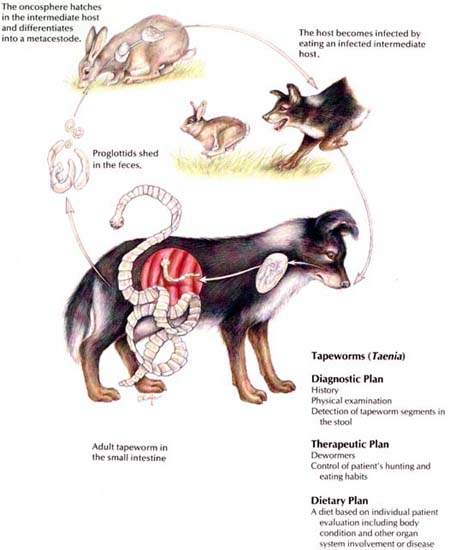 news is that even though these guys are a bit more icky than some of the other intestinal parasites (at least to me!) is that they are not as harmful as the round and whipworms in that they do not rob as much nutrients.
news is that even though these guys are a bit more icky than some of the other intestinal parasites (at least to me!) is that they are not as harmful as the round and whipworms in that they do not rob as much nutrients.
The most common tapeworm in dogs is Dipylidium caninum and is transmitted by lice and fleas. By keeping current on your flea and tick preventative, you can eliminate the intermediary host and prevent infection. The dog must bite or ingest an infected flea or louse in order for the parasite to cause an infection in the dog. Humans can also acquire d. caninum if they accidentally ingest an infected flea, so keeping your dog parasite free will also lessen your chances of contracting these parasites.
Other less common species of tapeworm include Taenia, found in sheep, rabbits, and rodents and capable of causing paralysis in dogs if the flesh of infected animals is consumed by the dog. Diphyllobothrium species, found in the organs of fish is endemic to Northern US and Canada. Echinococcus tapeworms, 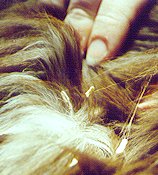 uncommon in dogs, are found in deer, elk, goats, sheep, cattle, swine, horses, and some rodents.
uncommon in dogs, are found in deer, elk, goats, sheep, cattle, swine, horses, and some rodents.
Treatment.
There are several drugs that are very effective in treating tapeworm: Droncit, Cestex, Drontal Plus, Telmintic, and Vercom Paste. As stated previously, the easiest way is prevention by eliminating the intermediary host- fleas.
GIARDIA
I remember looking at these guys under the microscope when I was a medic in the military. I  always thought they looked like a face with eyes and a crooked smile 😉 Giardia lamblia are tiny one-celled protozoa and are one of the most common intestinal parasites on both dogs and humans. Some dogs can carry this parasite benignly (meaning without symptoms) for years (called a latent or subclinical infection) until a stressor triggers an outbreak, known as Giardiasis. Giardia is so prevalent in North America because it is so contagious. As little as one ingested cyst can cause an infection! Most bacterial infections require THOUSANDS of the organisms to be consumed before it can overwhelm the body enough to cause an infection, but not giardia! One itty-bitty t-tiny microscopic organism can reproduce quickly enough inside the host to cause an infestation!! That is still crazy to me when I think about it! It is estimated that 5-10% of all dogs in North America have ACTIVE giardia at any given time with a much higher percentage carrying them inactively. Another veterinary report found that “100% of kennel dogs, 50% of pups, and 10% of well-cared for dogs carry giardia.” Because of the prevalence of Giardia, it is one of the parasites we routinely deworm for regardless of symptoms and one that we specifically request an ELISA test for on ALL our fecal floats. A negative fecal float DOES NOT always mean that the pup/dog is negative for parasites, especially in the case of giardia where it takes so little of the organism to effect the puppy. When a stool sample is tested, you are testing one small spot, spinning it in a centrifuge and looking at it under a microscope- so a negative stool sample just means that there was no parasites present IN THAT SPOT. But with the ELISA test, it is an ENZYME test that will test for the presence of Giardia REGARDLESS of whether the parasite was seen under the microscope, so, even though it still is not 100% conclusive, it is much more accurate. You can often have “no parasites seen” on a microscopic exam and still a positive ELISA test. This means that there was not a heavy enough load of the giardia to be seen on that spot that was examined under the microscope, however, that parasite was still present. If you suspect Giardia, always request an ELISA.
always thought they looked like a face with eyes and a crooked smile 😉 Giardia lamblia are tiny one-celled protozoa and are one of the most common intestinal parasites on both dogs and humans. Some dogs can carry this parasite benignly (meaning without symptoms) for years (called a latent or subclinical infection) until a stressor triggers an outbreak, known as Giardiasis. Giardia is so prevalent in North America because it is so contagious. As little as one ingested cyst can cause an infection! Most bacterial infections require THOUSANDS of the organisms to be consumed before it can overwhelm the body enough to cause an infection, but not giardia! One itty-bitty t-tiny microscopic organism can reproduce quickly enough inside the host to cause an infestation!! That is still crazy to me when I think about it! It is estimated that 5-10% of all dogs in North America have ACTIVE giardia at any given time with a much higher percentage carrying them inactively. Another veterinary report found that “100% of kennel dogs, 50% of pups, and 10% of well-cared for dogs carry giardia.” Because of the prevalence of Giardia, it is one of the parasites we routinely deworm for regardless of symptoms and one that we specifically request an ELISA test for on ALL our fecal floats. A negative fecal float DOES NOT always mean that the pup/dog is negative for parasites, especially in the case of giardia where it takes so little of the organism to effect the puppy. When a stool sample is tested, you are testing one small spot, spinning it in a centrifuge and looking at it under a microscope- so a negative stool sample just means that there was no parasites present IN THAT SPOT. But with the ELISA test, it is an ENZYME test that will test for the presence of Giardia REGARDLESS of whether the parasite was seen under the microscope, so, even though it still is not 100% conclusive, it is much more accurate. You can often have “no parasites seen” on a microscopic exam and still a positive ELISA test. This means that there was not a heavy enough load of the giardia to be seen on that spot that was examined under the microscope, however, that parasite was still present. If you suspect Giardia, always request an ELISA.
INFESTATION.
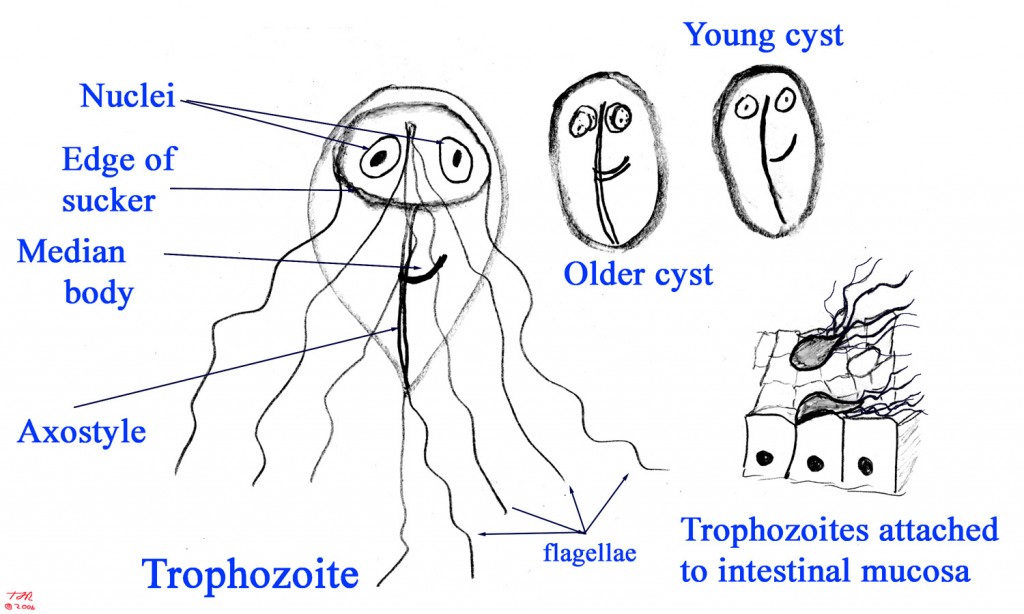 Giardia have what is called a direct life cycle, meaning there are no intermediary hosts required and the dogs become infected when they ingest the cyst (also called the “oocyst”) form of this parasite by drinking contaminated water, eating contaminated food, licking contaminated fur or otherwise coming into contact with contaminated feces in the environment. This part of the giardia life cycle is non-motile. Once ingested, the cyst lodges in the upper part of the dog’s small intestines (called the duodenum). Here each cyst produces several motile (moving) larvae know as trophozoites. The teat shaped trophozites have 4 sets whiplike flagella to propel them. They reproduce asexually through binary fission (meaning each mature trophozoite is capable of splitting into two individual giardia organisms. These parasites irritate and damage the dog’s intestinal track lining and can cause malnutrition, severe diarrhea and loss of appetite. Before the parasite leaves the dogs body, it encysts to from an oocyst, which, once shed from the dog in his feces, is capable of immediately reinfecting another host. In a moist environment, the cysts are capable of surviving for months waiting on a new host.
Giardia have what is called a direct life cycle, meaning there are no intermediary hosts required and the dogs become infected when they ingest the cyst (also called the “oocyst”) form of this parasite by drinking contaminated water, eating contaminated food, licking contaminated fur or otherwise coming into contact with contaminated feces in the environment. This part of the giardia life cycle is non-motile. Once ingested, the cyst lodges in the upper part of the dog’s small intestines (called the duodenum). Here each cyst produces several motile (moving) larvae know as trophozoites. The teat shaped trophozites have 4 sets whiplike flagella to propel them. They reproduce asexually through binary fission (meaning each mature trophozoite is capable of splitting into two individual giardia organisms. These parasites irritate and damage the dog’s intestinal track lining and can cause malnutrition, severe diarrhea and loss of appetite. Before the parasite leaves the dogs body, it encysts to from an oocyst, which, once shed from the dog in his feces, is capable of immediately reinfecting another host. In a moist environment, the cysts are capable of surviving for months waiting on a new host.
TREATMENT.
If giardia is confirmed or suspected, the 2 most common medications administered are Metronidazole (Flagyl) or Fenbendazole (Panacur).
COCCIDIA
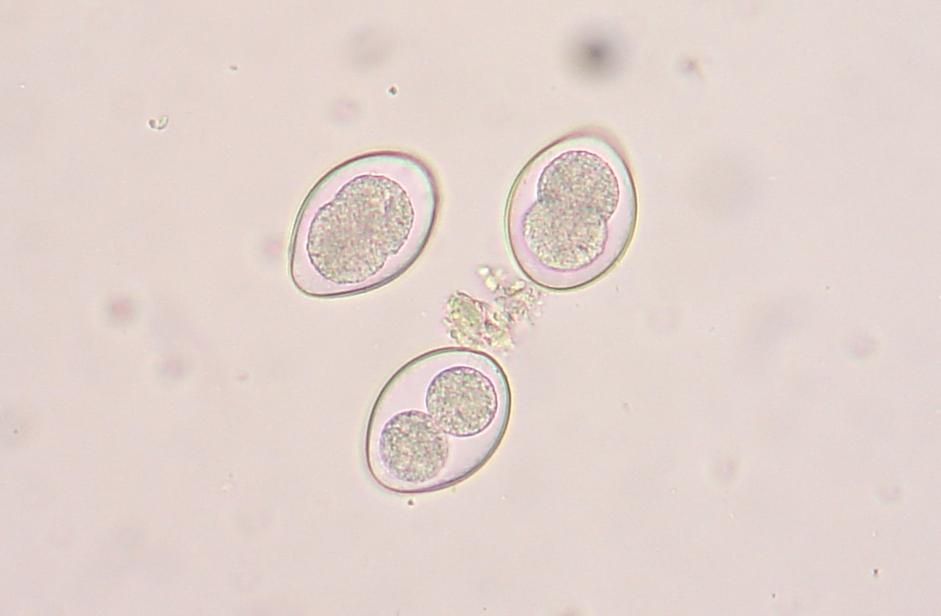 Coccidia has to be one of my least favorite parasites! It can be VERY tricky to treat because just like giardia, it can lay dormant for months or even years without any clinical symptoms. It is opportunistic and waits for the host to have a stressor to trigger and outbreak (moving, change in diet, change in weather, pregnancy, etc.). Coccidia is so prevalent that it is considered to be present in the digestive track of every dog. Coccidia is credited with being the number one cause of “new puppy diarrhea.” (When a healthy puppy goes to his/her new home and then develops diarrhea shortly after arriving). This happens because even if the puppy was dewormed specifically for coccidia, it would only eliminate any active coccidia and not any that are encysted in the tissue. The obvious problem being that if the puppy is happy and healthy in his current home, there will be no active parasites and therefore the deworming will be futile. And of course, once stress triggers an outbreak, the puppy is in his new home. However, unlike most other parasites, a dog CAN
Coccidia has to be one of my least favorite parasites! It can be VERY tricky to treat because just like giardia, it can lay dormant for months or even years without any clinical symptoms. It is opportunistic and waits for the host to have a stressor to trigger and outbreak (moving, change in diet, change in weather, pregnancy, etc.). Coccidia is so prevalent that it is considered to be present in the digestive track of every dog. Coccidia is credited with being the number one cause of “new puppy diarrhea.” (When a healthy puppy goes to his/her new home and then develops diarrhea shortly after arriving). This happens because even if the puppy was dewormed specifically for coccidia, it would only eliminate any active coccidia and not any that are encysted in the tissue. The obvious problem being that if the puppy is happy and healthy in his current home, there will be no active parasites and therefore the deworming will be futile. And of course, once stress triggers an outbreak, the puppy is in his new home. However, unlike most other parasites, a dog CAN  build an immunity to the parasite. For this reason, serious infections are rarely seen in dogs or cats over the age of 6 months. After the dog builds an immunity to coccidia, he can still shed cysts in his feces, but experience no effects from the parasite.
build an immunity to the parasite. For this reason, serious infections are rarely seen in dogs or cats over the age of 6 months. After the dog builds an immunity to coccidia, he can still shed cysts in his feces, but experience no effects from the parasite.
Unlike some of the other parasites, coccidia cannot be transmitted to the puppy while he is in the uterus or via the milk. Coccidia is only a fecal oral transmission. Meaning the puppy is constantly exposed to her mother’s feces (rooting for milk, anything she has stepped in or sat in and tracked back inside her whelping box, etc.) If the mother is shedding any infective cysts, the puppy will become infected. Similar to giardia, once the oocyst of coccidia are ingested, the oocsyt encysts in the small intestines and the sporozoites contained within the oocyst are released. Each sporozoite embed in the cells of the hosts small intestines and reproduce asexually by division. The resulting merozoites infect new cells. One cyst of coccidia can quickly divide into 10’s of thousands. Because the young puppy will have no natural immunity, the ingested parasite will multiply is mass numbers and quickly overwhelm the puppy. Diarrhea, dehydration, loss of appetite and even death can result.
TREATMENT.
The recommended course of treatment for coccidia us usually Albon. For a long time we have given our puppies a round of albon 10 days prior to leaving for their new home, but as mentioned previously, if there is no active case of outbreak, this is a fruitless effort. We have had a few of our puppies present with coccidia after going home, and after much frustration with the issue, MANY long discussions with my vet and other breeders, Dr. Jeff consulted with a parasitologist for me and the information he gleamed from the parasitologist, my combined research with several other vets (some of the vets were GR Puppy owners, so I know the advice and concern was genuine!) we have decided on a new game plan. First, we are now implementing a new dewormer in our program called Marquis. This product is labeled for horses, but research has shown it to be VERY effective in PREVENTING coccidia in puppies. It is substantially more expensive than the albon (about $800 for a case of Marquis!) but if it is as effective as it promises to be, then it will be well worth it! We have also started implementing a product called “cocci-guard”. It is a powder that is added to the dry food for daily use, ESPECIALLY during times of stress or transition of a puppy to a new home. All of our puppies will come with a bag of dog food that has cocci-guard added. Since we have implemented this new strategy, we have not had a single case of coccidia, however, we are still very new to this program, so I will not claim to have eradicated it just yet. I would STRONGLY recommend any breeder or handler struggling with coccidia to talk to your vet about MARQUIS and COCCI-GUARD! Marquis requires a prescription and many vets will not script it for coccidia in dogs as this is an “off label” application, but I am so thankful that Dr. Jeff is not only open-minded of possible new advances, but has always trusted my opinions regarding my dogs. We do still give a round of Albon as well for 10 days prior to the puppy going home just in case.
The following is Guardian Rottweilers de-worming protocol and it, along with all information on this page or website is NEVER meant to take the place of veterinary council and is simply offered for the possible education of dog owners.
PUPPIES:
4 days of age: Marquis
1 week: Pyrantel Pamoate
2 weeks: Marquis and Pyrantel
4 weeks: Marquis and Pyrantel
6 weeks: Marquis and Panacur
8 weeks: Marquis and Panacur
We also start adding probiotics to their food at 4 weeks of age and add the cocci-guard to their food at 6 weeks of age as well as to the mom’s food. All of our adults are on daily probiotics and cocci-guard. The first bag of food we send home with our puppies will have cocci-guard already added.
Adults- all youth and adults are on Advantix and Interceptor. We will also deworm quarterly with Albon and Panacur prophylactically. We do random fecal exams every few months and also if any of our dogs have diarrhea that does not clear up within a few days.
Tips:
• Deworming can often cause diarrhea. If this happens, you can add canned pumpkin, baked or boiled and smashed sweet potato, yogurt or cottage cheese to their food to help firm up stools.
• A negative fecal exam DOES NOT necessarily indicate a dog that is parasite free. Keep in mind, many parasites shed randomly in the stool and then you are only testing a small portion. So, you are planning for 1) the parasite to be shedding at that time and 2) to have tested the spot where it was shed. If you have not changed anything in the diet and clinical exam points towards a parasite, especially if you have been in likely places (woods, ponds, fields, dog parks, etc.) I would suggest a round of a broad spectrum dewormer followed by a repeat stool exam one week after.
• If parasites have been ruled out (you have already dewormed and still no symptom changes), try probiotics- your dog’s gut balance could be off. Dewormers and antibiotics eliminate everything in the gut- often the good as well as the bad. So sometimes you need to reseed your dogs digestive track with the good bacteria necessary for digestion. Also look into both the food and any treats you are feeding to see if there are potential allergens. Owner will often heavily scrutinize the dog food they feed but FORGET that wheat, corn, soy, etc. should not be in the treats either.
• A bland diet of boiled hamburger (preferably ground sirloin or another cut that is lower in fat) and rice can help sooth an upset tummy.
• Keep in mind that MANY parasites are opportunistic- meaning they can be with your dog just laying inactive in the gut or other tissue for YEARS and only become active during times of stress (moving, new home, new family member, new diet, new schedule, illness, etc.)
• Also keep in mind that getting a new puppy is stressful on the puppy AND your current pets. It is not uncommon for the addition of a new puppy to upset other dogs or pets already residing at the new home. If you have another pet that presents with upset tummy shortly after you bring your new puppy home, it is likely that he/she had inactive parasites and the stress of the new addition triggered an outbreak. Do not forget to check stool of other pets as well. I would also suggest a probiotic to be started on other furkids prior to and during the new addition (and the new addition can be a human also- some dogs that are already quite bonded can feel displaced at the addition of a new human to the family, so be sure to let your dog know that he/she is still loved and wanted and valued).
• If you have a confirmed case of intestinal parasites in your dog and you have other pets, find out if they are susceptible (most parasites are specific to a certain species, but some can infect other species as well). Any additional pets that are susceptible SHOULD BE DEWORMED at the same time REGARDLESS of symptoms.
• Some parasites ARE capable of being contracted by humans so GOOD HANDWASHING HABITS are a MUST when you have pets (and really should be a MUST even if you do not have pets!) Kids especially will often snack or sit down to eat after playing with the family pet or outside where the family pet may defecate. Insist on thorough hand washing with your kids especially before any food is handled. **Let me also point out that simply using antibacterial lotion is NOT a substitute for good handwashing!!!!! It is labled “antibacterial” for a reason! It is against bacteria ONLY! It will do nothing for microorganisms, viruses, parasites, etc. This same philosophy translates to us regardless of the presence of pets! I get so annoyed at everyone ESPECIALLY clever marketing ploys that suggest ussage during “cold and flu season”. Colds and flu are VIRUSES and rubbing this liquid on your hands WILL NOT do ANYTHING to the virus!!! WASH YOUR HANDS!!!! There really is no substitute for a thorough hand washing of 30 seconds (you can sing your ABC’s).
• Keeping a clean yard is the single greatest thing you can do to help prevent parasite infestations in your pets- tied right up there with your monthly preventatives for level of importance. Parasites enter the ground though feces that have been left there. If you stay on top of all “dogy duty” you will have a SIGNIFICANT impact on the potential parasites in your environment.
Intestinal Parasites are certainly one of the most annoying parts of owning a pet, but they do not have to define your pet. I have a whole herd of Rottweiler, 2 kitties, an minimum of 4 kids here every day (and often in addition to my 4 there are several others: neighbor kids, kids from school or church- some kids have pets that follow them home, and my kids certainly do that also, but they also have stray kids that follow them home 😛 It is not uncommon for my kids friends to come for dinner and 2-3 days later, they are still here!) and we have had a PLETHORA of small and not so small animals including bunnies, roosters/chickens, pot bellied pigs, turtles, ferrets, birds, sugar gliders, etc. and intestinal parasites have never been a issue. Sure they crop up every now and again, but most are caught through prophylactic/ routine treatment prior to any symptomatic presentation.
IMPORTANT TO NOTE: Deworming alone WILL NOT RID YOUR PET OF PARASITES if they are still consuming them in their environment or off of themselves! Routine grooming is essential, but ESPECIALLY when battling intestinal parasites- it is suggested that you give your pet a THOROUGH bath on the first, third, fifth and last day of treatment as well as keep them completely free of feces in between. Kennels and bedding must also be washed thoroughly. As already mentioned, scooping behind your pet EVERY TIME they go potty is ESSENTIAL when treating for parasites! If you are deworming them to kill what they have in their bellies, but they are consuming them again immediately after, you can be battling this for a much longer period of time!!






